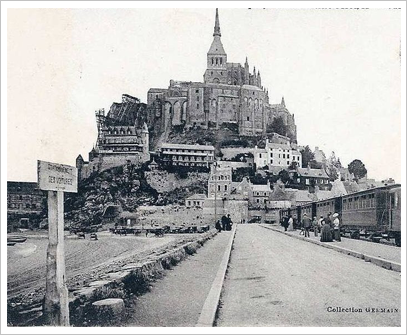HISTORY

In the 8th century
The long history of Mont-Saint-Michel is thought to date back to 708, when Aubert, Bishop of Avranches, had a sanctuary built on Mont-Tombe in honour of the Archangel. Mont Saint-Michel was used in the sixth and seventh centuries as an Armorican stronghold of Gallo-Roman culture and power until it was ransacked by the Franks, thus ending the trans-channel culture that had stood since the departure of the Romans in CE 460.
From roughly the fifth to the eighth century, Mont Saint-Michel belonged to the territory of Neustria, and in the early ninth century was an important place in the marches of Neustria.
Before the construction of the first monastic establishment in the 8th century, the island was called Mont Tombe (Latin: tumba). According to legend, the Archangel Michael appeared in 708 to St. Aubert, the bishop of Avranches, and instructed him to build a church on the rocky islet. Aubert repeatedly ignored the angel's instruction until Michael burned a hole in the bishop's skull with his finger.
The mount soon became a major focus of pilgrimage. In the 10th century, the Benedictines settled in the abbey, while a village grew up below its walls.

In the 11th century
In the 11th century, the Romanesque abbey church was founded over a set of crypts where the rock comes to an apex, and the first monastery buildings were built up against its north wall. In the 12th century, the Romanesque monastery buildings were extended. In the 13th century, a donation by the king of France, Philip Augustus, in the wake of his conquest of Normandy, enabled a start to be made on the Gothic section.
In the 14th century
In the 14th century, the Hundred Years War made it necessary to protect the abbey behind a set of military constructions, enabling it to hold out against a siege lasting 30 years.
In the 15th century, the Romanesque chancel of the abbey church, broken down in 1421 was replaced by the Gothic Flamboyant chancel. With Rome and Saint Jacques de Compostelle, this great spiritual and intellectual centre, was one of the most important places of pilgrimage for the Medieval occident. With Rome and Saint Jacques de Compostelle, this great spiritual and intellectual centre, was one of the most important places of pilgrimage for the Medieval occident.
The wealth and influence of the abbey extended to many daughter foundations, including St. Michael's Mount in Cornwall. However, its popularity and prestige as a centre of pilgrimage waned with the Reformation, and by the time of the French Revolution there were scarcely any monks in residence.
A world heritage
UNESCO has classed the Mont Saint-Michel as a world heritage in 1979 and this mecca of tourism welcomes more than three million visitors a year.



